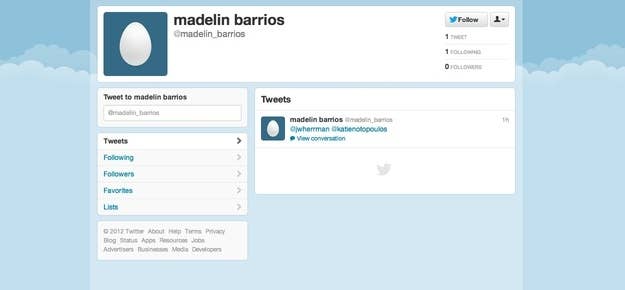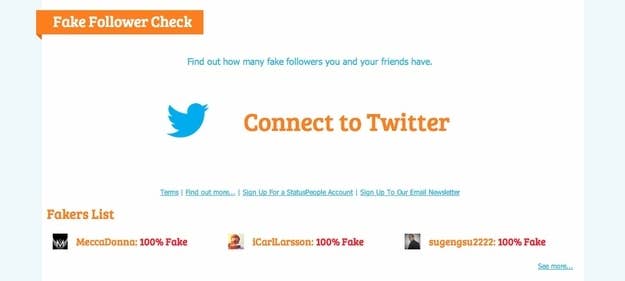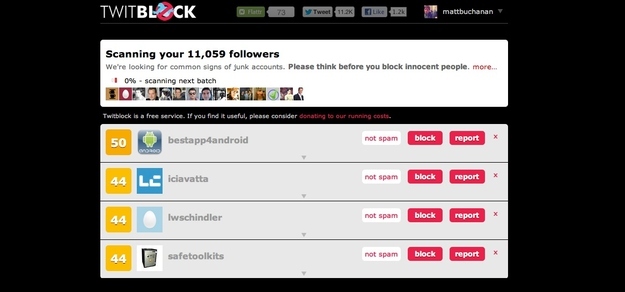
I've gotten sick of looking through my Twitter followers list and seeing it littered with people who follow tens of thousands of junk accounts. So over the past few months, I've been actively policing my new followers. Any user that follows me and is clearly a bot, or just looking for people to follow back, gets blocked and reported for spam. Random web design companies, auto repair shops, and fashion boutiques: reported for spam.
It seems I'm not alone. Recently StatusPeople, a social media management platform for businesses, launched a tool to find out how many of a user's followers are spam or inactive accounts. While their algorithm is far from perfect (based on only the most recent 500 followers for a given account), it's already being used to analyze the presidential race. People are beginning to wake up to the reality that anyone can gain a bunch of followers with fifty bucks and enough CPU cycles.

For those who aspire to some kind of fame, even Internet fame, Twitter looks like a great in. It is, in many senses, a meritocracy, with the smartest, funniest, or most interesting accounts eventually gaining a large following. But, unsurprisingly, many people were unsatisfied with their tiny feifdoms of followers on the social network. Armed with the early revelation that most users tended to follow back a percentage of those who followed them, these people set out to follow as many people as they could as a way of gaming the system. The process of following, however, was both laborious and excruciatingly boring.
Then someone wrote a script that automated it.
While the early hack developed by Danilo Salles above was probably one of many similar scripts written at the time, it was indicative of an early trend towards automated following. And even though Twitter originally limited people to following 2,000 people (and out-of-date support documents still say it does), the limit was lifted eventually, and the scripts became smart enough that they managed to avoid raising any red flags.
Mitt Romney recently made headlines when it was revealed that the spike of 150,000 new followers from July 20-23 was comprised of only 74% real people, compared with 90 percent for accounts of similar size [Romney denied buying followers]. How many of those followers not counted by The Atlantic as bots are just follow-back spammers, many of which target large accounts?

The Problem with Follow-Back Spam
As far as spam goes, automated posting bots have been around since the dawn of the internet. Their use has been generally restricted to the domain of those with enough knowledge of software development to write the large, distributed systems needed to make money with them.
But this is a new type of spam that no one has ever had to deal with: lots of real people using commercial tools to mass-follow others. The prevalence of follow-back spam is a testament to our need for validation — a numerical representation of our social capital — and its ubiquity makes it difficult to police effectively.
Spam bots are fairly easy for Twitter to spot: they generally either have no tweets and contain links in their bios to sites that sell porn or Viagra, or just follow and reply to random users with similar links.
When the account has a real person behind it, however, it's more difficult for a spam algorithm to distinguish users who are auto-following to juice their numbers from users like Robert Scoble, who follows back all users who follow him.
While they're tough on Twitter's anti-spam algorithms, most of the people using auto-follow scripts are easy for a human to spot. They either don't tweet at all, or mostly just shill. Many of them have links to the auto-follow sites in their timeline. They follow thousands upon thousands of people, often selectively unfollowing accounts that don't follow back to stay around a 1:1 ratio of followers-to-following and avoid tripping the spam alarm.
Why You Should Report Spam Accounts
It's simple: very few people actually do. And while ganging up with a bunch of friends to report an innocent account won't get it suspended, consistently reporting real spammers does work. If you're older than 35 and it helps, you can think of it as picking up litter off the streets of the Information Superhighway.
There's another reason to regularly report spammers who follow you: somehow, it feels more honest. I'd rather know that I have a few hundred actual people reading my tweets than watch my follower count go up while having no idea how many are just bots or follow-back spammers.
While watching new followers pour in can make for a quick dopamine fix, wouldn't you rather see when you did something cool that attracted actual followers? You'll never know if the real people are buried under reams of spammers.

How to Keep Your Followers Spam-Free
For most users — those who don't gain a ton of followers every day — my daily cleanse routine should work well enough. Every day (or every few days), check your new followers and report the spammers manually. It takes a couple of minutes, which is a drop in the bucket compared to many users' daily Twitter usage. An added benefit is that when someone interesting follows you, you'll be more likely to discover them as well.
If you have a five- or six-digit follower count, or if you have more than a hundred followers and are doing it for the first time, this method won't be practical. In that case, you'll have to break out the napalm.
Back in 2009, Tim Whitlock released an app called Twitblock. The tool scans your Twitter followers, runs a series of checks on the accounts, and tells you which ones are most likely to be spam. You can drill down into the list to see exactly why an account was flagged and block or report offenders quickly.
Twitblock uses a complex algorithm that factors how many users an account follows per day, its age, how many of the profile fields are blank, and whether or not other Twitblock users have reported it for spam. Interestingly, it also takes into account how frequently the avatar appears among other accounts, a common marker for porn bots. The app assigns each user a score, and orders them with the most likely spammers at the top.
Twitblock doesn't allow you to mass-report users in order to avoid flagging innocent people as spam. Still, it's quick to use, and if you turn it into a little game then it's slightly more fun than playing Farmville (hell, Twitter should be turning this into a game anyway). StopTweet, on the other hand, is a similar service that does auto-reporting and allows some customization of how aggressive the filter is.
Regardless of how you do it, policing your Twitter followers is worth at least considering. Do you really care how many followers you have? I'd rather know how many actual people are paying attention.
Ben Jackson is an iOS developer and writer living in Brooklyn, NY. He worked on news reader apps for the New York Times, and currently works on apps for Longform.
